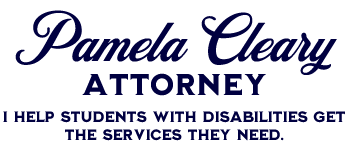Section 504 Plan

At Cleary/Fowler, we represent students who have been discriminated against as a result of their disability.
Of the 53.9 million school-aged children in the U.S., about 2.8 million (5.2 percent) were reported to have a disability in 2010. These disabilities include physical limitations (vision/hearing impairment, limited mobility, chronic disease or illness) and mental impairments (learning disabilities, depression, developmental delays).For these students, attending school may present additional challenges--for example, how will a hearing impaired student listen to the teacher's instruction? How will a student with diabetes ensure his insulin is properly administered? How will a wheelchair-bound student get to and from the classroom?
The answer is provided in a Section 504 plan. A Section 504 plan is a written document provided by the school district that sets out the reasonable accommodations and modifications necessary to ensure that a student with a disability receives equal access to the learning environment.
A Section 504 plan is derived from the Rehabilitation Act of 1973 and the Americans with Disabilities Act, both of which prohibit discrimination against schoolchildren on the basis of disability. A violation of Section 504 is a violation of the student's civil rights.
Schools are required to develop 504 plans for eligible students. A proper 504 plan will explain the accommodations and modifications that the school will make to the physical and instructional environment to ensure that disabled children have an equal opportunity to learn.
What's the difference between an IEP and a 504 plan?
Put simply, Section 504 targets equal access, while the IDEA addresses instruction.
Section 504 is a civil rights law that prohibits discrimination against disabled individuals. A 504 plan is a written document that explains how the school will accommodate a child with a disability to ensure he or she receives equal access to the learning environment (and is, thereby, not discriminated against). In contrast, an individualized education program ("IEP") is developed pursuant to the Individuals with Disabilities Education Act ("IDEA") and sets out the instructional methods that a school will use a part of a program of special education.
For example, a wheelchair-bound student with no academic difficulties would be eligible for a 504 plan, but would not be eligible for an IEP and special education, due to the lack of academic difficulties.
Who is eligible for a Section 504 plan?
Anyone who:
- has a physical or mental impairment which substantially limits one or more of such person's major life activities;
- has a record of such impairment; or
- is regarded as having such impairment.
What does a Section 504 plan do?
Each 504 plan is tailored to the individual student's needs, and so each plan is different. Some things a 504 plan can do include:
- establish procedures for dispensing medications
- provide accommodations on standardized tests (e.g., preferential seating, longer test time, quiet environment)
- food allergy accommodations
- installation of ramps/accessibility/mobility aids
- visual/auditory aids (color coded worksheets, hearing devices)
- accommodate medical absence by providing makeup work/homebound work etc.
- service animals
How do I get a 504 plan?
The school must be informed of your child's disability before any accommodations will be provided. Most school districts have a district-wide form used for requesting accommodations. If you think your child may be in need of accommodations, contact the school directly.
